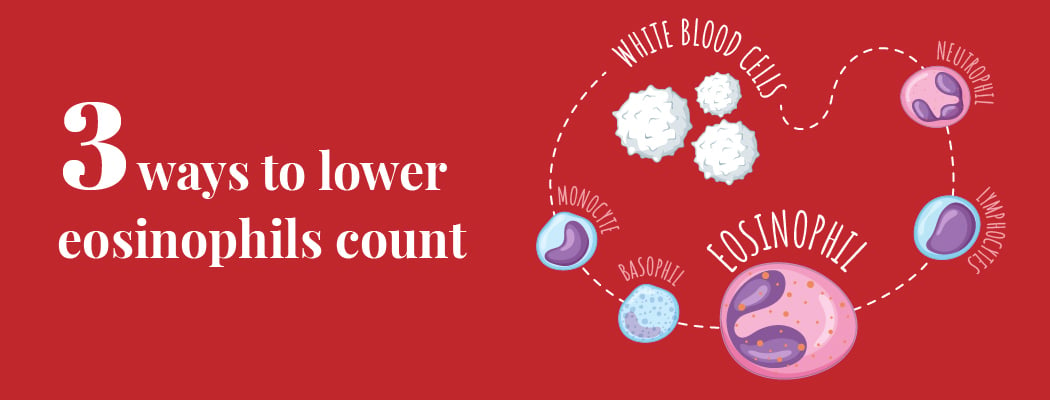How to Reduce Eosinophil Count
January 22, 2025

Eosinophilia is a condition in which your body produces excessive eosinophils. One type of white blood cell that helps your immune system is the eosinophil. Specific medical conditions and medications can occasionally bring on high eosinophil levels.
What is Eosinophilia?
Eosinophilia is characterized by an unusually high number of eosinophils in your blood (500 or more per microliter). They support your body’s immune response to allergens and fight against parasitic and fungal infections. High eosinophil counts might be a side effect of some medical conditions and medicines.
How Severe is Eosinophilia?
The degree of eosinophilia might be minor, moderate, or severe, depending on your eosinophil count. High eosinophil levels may signify a minor illness, such as an allergic reaction to a medication, or a more severe condition, such as various blood disorders. Sometimes, large concentrations of eosinophils gather in one spot on your body, leading to inflammatory diseases that can affect several parts of your body.
Causes
Your blood’s eosinophil count rises as a result of numerous conditions. Some symptoms, such as seasonal allergies, asthma, and medication responses, are prevalent and frequently not very serious. Eosinophilia can also come from infections, particularly parasitic ones. Impaired immune systems, such as autoimmune diseases like sarcoidosis, autoimmune myocarditis, vasculitis, and inflammatory bowel disease, can also bring eosinophilia. Eosinophilia can also result from blood cancers that produce these cells unnecessarily. Finally, hereditary genetic variations (inherited from your biological parents) might result in eosinophilia.
What Might Occur if Eosinophil Counts Are Increased?
Eosinophils can occasionally induce inflammation in particular body parts. Eosinophilic disorders or hypereosinophilia syndrome (HES) are terms used to describe this condition. The parts of your body that are afflicted are termed for particular eosinophilic disorders.
Eosinophilic disorders include:
- Eosinophilic cystitis: This affects the bladder.
- Eosinophilic fasciitis: This is a disorder of the fascia, which is the connective tissue that extends throughout the body.
- Eosinophilic pneumonia: This affects your lungs.
- Eosinophilic gastrointestinal disorders (EGID): EGID includes eosinophilic esophagitis, which affects your esophagus, colon (large intestine), stomach, and small intestine.
- Eosinophilic granulomatosis with polyangiitis (EGPA): This is also known as Churg-Strauss syndrome and affects your lungs, heart, sinuses, and other organs.
- Eosinophilia symptoms: The presence of eosinophilia rarely causes symptoms. Typically, conditions with several underlying symptoms are the source of high eosinophil levels.
Diagnosis
Usually, a complete blood count (CBC) with a different white blood cell count, a common blood test, detects eosinophilia. Your doctor may do additional tests as necessary to determine the cause of your high eosinophil levels.
Prevention
The most commonly cited reason for high eosinophil levels is allergies. Eosinophilia brought on by allergies can be avoided with medication to manage your body’s allergic reactions. Eosinophilia, however, can occasionally be a symptom of a more serious problem that you may not be able to treat.
How to Reduce Eosinophils?
High eosinophil counts, also known as eosinophilia, may seem alarming, but they are typically just your body’s normal reaction to infection. White blood cells called eosinophils help your body fight infections by inducing inflammation. As a result, eosinophil levels usually decrease after the underlying cause has been treated. Nevertheless, promoting a healthy lifestyle and using anti-inflammatory medications may help lower unusually high levels.
Reduce your stress levels: Your eosinophilia may be brought on by conditions that are caused by stress and anxiety. You can control your eosinophil levels by relaxing for a while. First, check your everyday activities for potential sources of stress. Then, avoid or minimize your contact with stressful triggers whenever you can. When you’re feeling stressed or overwhelmed, relaxation techniques like meditation, yoga, and muscle relaxation might help you relax.
Reduce your exposure to allergies: Allergies are the most frequent reasons for a high eosinophil count. You can control eosinophils in your body by treating allergies and avoiding triggers.
Keep your home spotless: Particularly if you have a dust mite allergy, dust mites might irritate certain people and lead to a reaction that may increase eosinophils. Try to maintain your house as spotless as you can to prevent this. To prevent dust mites from gathering in your home’s corners, dust at least once a week. For some people, pollen can have a similar impact. During peak pollen seasons, keep your doors and windows closed to keep pollen out of your home.
Eat a healthy diet free of acidic foods: Both acid reflux and heartburn can raise your body’s eosinophil count. To avoid these conditions, one must eat a balanced, healthy diet. Look for low-fat foods, including lean meats, whole grains, fresh fruits and vegetables, and whole-grain foods. You should avoid acidic meals, including fried foods, tomatoes, alcohol, chocolate, mint, garlic, onions, and coffee. People who are overweight are at a higher risk of experiencing acid reflux and having elevated eosinophil counts.
Quit smoking and limit alcohol consumption: Your eosinophil counts may improve if you stop smoking. Although there is no specific proof that cutting back on alcohol lowers eosinophil levels, doing so will undoubtedly enhance your general health. Have a workable plan and ask for support when trying to stop smoking.
Home Remedies to Reduce Eosinophil Count
Boost your daily vitamin D consumption: High eosinophil counts are more common in people with low vitamin D levels. You can improve your vitamin D consumption in two different ways. First, at least twice a week, spend five minutes in the sun (for those with extremely light skin) or thirty minutes (for those with darker skin). Alternatively, you can take a vitamin D3 supplement. Be outside to gain vitamin D through sun exposure. Sitting next to a sunny window won’t help since vitamin D is produced by UVB rays, which cannot pass through glass. Spend extra time outside on overcast days because cloud cover cuts down on the sun’s rays.
Reduce inflammation by consuming ginger: Inflammation is known to be reduced by ginger. Although research is ongoing, ginger may also help lower eosinophils. To reap the benefits, take ginger supplements daily or brew ginger tea. The majority of grocery stores sell ginger tea. Put the tea bag in a cup and pour it with hot water. Before consuming, let it brew for a while.
Turmeric reduces inflammation: In some cases, turmeric may help reduce eosinophils. Purchase turmeric at a greater dose in the form of capsules if you want to benefit from its anti-inflammatory properties.
The doctor who treats this disorder is a hematologist who specializes in blood disorders and an immunologist who specializes in disorders of the immune system.
Frequently Asked Questions
1. Which food reduces Eosinophils?
Fruits and vegetables help in reducing eosinophils. In addition, your immunity is boosted by honey, turmeric, pepper, garlic, and ginger.
2. Can exercise reduce Eosinophils?
Various studies indicate that aerobic exercises can reduce Eosinophils.
3. Can Vitamin C reduce Eosinophils?
The eosinophil counts in allergic rhinitis are decreased by vitamin C.
4. Should I worry about high Eosinophils?
Even though a high eosinophil count, also known as eosinophilia, may sound worrying, it is typically just your body’s normal response to an infection. White blood cells called eosinophils assist your body in fighting infections by inducing inflammation. As a result, eosinophil levels usually decrease after the underlying cause has been addressed. Nevertheless, leading a healthy lifestyle may also help lower exceptionally high levels.







